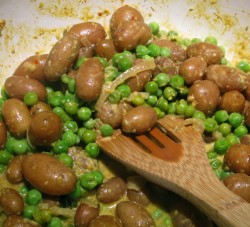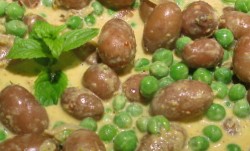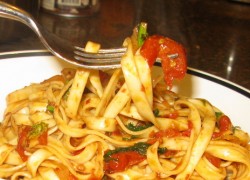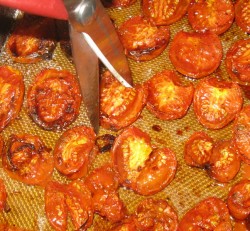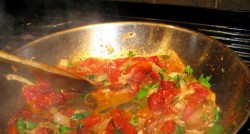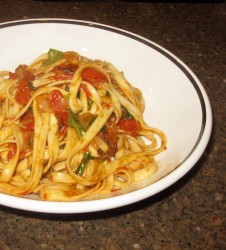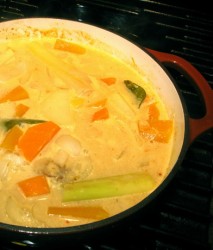Meatless Monday: Aloo Mattar
I adore tiny French fingerling potatoes, especially when they are just dug from the earth and scrubbed of mud. The little bite-sized ones are amazingly sweet with the most lovely contrast between the earthy, slightly bitter skins and their creamy, nutty-sweet flesh.
When you boil them, their skins pop under your teeth, releasing the meltingly-soft interior, and make a symphony of texture in the mouth: snappy skin that goes tender as soon as the potato’s integrity is breached, contrasting with the yielding smoothness of the tuber itself. If you add in peas–fresh are great, but good frozen ones work wonderfully as well–you get the same sort of texture in the green vegetable: a pop of skin and a burst of flavor from the velvety soft flesh.
I extemporized this curry because I had bought these adorable tiny potatoes from Rich Tomsu at the farmer’s market and really wanted to feature them in a recipe that would make them shine. Peas and new potatoes are a classic combination–I grew up eating them with cream or evaporated milk, and sometimes tiny pearl onions.
I wanted to do a gently spiced Indian version of peas, tiny potatoes and a dairy product, so what I came up with was Greek yogurt and a tiny bit of cream. Only enough to help thicken the sauce along.
The main spice in this curry is, believe it or not, fresh turmeric root.
I have seen fresh turmeric root appearing in Indian grocery stores more and more often these days, and when I see it, I buy it up gleefully. I love the way it smells and tastes, and the fresh, tingling, lightly medicinal flavor and scent it imparts to curries is amazing. Besides, if you are careful, and don’t let them stay too damp so that they mold, you can keep the fresh rhizomes for up to a month in your fridge. So, if you like the flavor and color that fresh turmeric imparts to Indian and Thai dishes, by all means, pick it up.
And–if you have never tried fresh turmeric root and you see it in the store, get some. Try it! It is delicious, and is filled with anti-oxidants and anti-inflammatory agents. It is very, very good for you.
What does it taste like? Fresh turmeric has a lightly sweet, somewhat medicinal, flowery taste, a little bit like its cousin, fresh galangal, but not as strong. It is nowhere near as peppery and “hot” in flavor as its other cousin, ginger, It is pleasant, and the slight bitterness of flavor and lightly “dusty” scent that it has dried is not really present in the fresh rhizome.
You do have to wear gloves when you peel it–the powerful yellow coloring in it will stain fingers (it is used as a dye in India, Southeast Asia and China, particularly for Buddhist monk’s robes) after just a short contact with skin.
You can peel and grate it just like ginger, or if you have a good, strong food processor/spice grinder like my Preethi, you can just peel and roughly slice it and stick it in with the other spices and aromatics to be ground into a thick, highly scented, orangish paste.
I kept the spicing for this vegetarian curry fairly simple–I really wanted the fresh turmeric to shine. I used some coriander seed, a little fennel seed, some cardamom and a couple of peppercorns for kick, as well as a single garlic clove and a well-browned shallot.
The result was a lightly sweet curry, fragrant with spices in a thick, creamy, pale daffodil yellow sauce. It isn’t very saucy, because I wanted the peas and potatoes to take center stage, so I reduced the liquid so that it thickened and clung to the vegetables, leaving just a little bit of sauce in the bottom of the pan to drizzle over the rice.
I finished the curry with a squeeze of lemon juice and a sprinkle of chopped fresh mint from the porch garden. As cold as it has been, the mint is yet going strong.
The curry turned out very well–I know this for a fact because Dan finished his portion of it before he finished his rogan gosht, which is a favorite of his. I took that fact as a sign that this recipe is a keeper and will be appearing on my table again, probably in the near future.
So long as I can get Rich’s fabulous tiny potatoes, that is.
Aloo Mattar
Ingredients:
1 pound of the smallest French fingerling or other tiny potatoes, well scrubbed
1 teaspoon salt
1/2 tablespoon ghee
1 very large shallot, peeled and very thinly sliced
1 garlic clove, peeled and sliced
1 teaspoon fennel seeds
1/4 teaspoon peppercorns
2 1/2 teaspoons coriander seed
6 green cardamom pods
3/4 inch cube (approximately) fresh turmeric root, peeled and sliced
8 ounces frozen peas, thawed
3/4 cup whole or 2% Greek style yogurt
2 tablespoons heavy cream
salt to taste
lemon juice to taste
1/8 cup minced fresh mint for garnish
Method:
Put the potatoes into a pot, cover with cold water, add the salt and bring to a boil. Turn down heat and simmer until they are fully tender–about ten or fifteen minutes if the potatoes are truly small.
In the meantime, heat the ghee in a heavy-bottomed pan. When it melts, add the shallot, and cook, stirring as needed, until the shallot is a dark golden brown color. While the shallots cook, grind up the spices from the garlic clove through to the turmeric root into a fragrant, orange-brown paste. When the shallots are golden, add the spice paste, and cook, stirring constantly, for about five minutes. Don’t worry if some of the paste sticks to the bottom of the pan–so long as they just brown and don’t burn, this will only add flavor to the finished curry.
Add the peas, the yogurt and the heavy cream. Drain the cooked potatoes and add them to the pot, and cook, stirring, until the curry begins to thicken. As soon as you add the yogurt and cream, start scraping any browned bits off the bottom of the pan into the sauce. The sauce should color fairly quickly to a pale yellow hue.
Keep cooking the curry until the sauce reduces and thickens enough to coat the back of a spoon pretty heavily. The color will deepen slightly to a pale jonquil tone. Remove immediately from the heat, stir in salt as needed, add the lemon juice to your taste and stir in the mint leaves.
Serve immediately with steamed basmati rice.
The leftovers from this dish rock–the turmeric flavor only deepens overnight in the fridge, and the reheating melds all of the spices together beautifully.
Another Health Update: The Gallbladder is Fine
So, in an odd twist of luck, I had my ultrasound on Friday morning. I woke up after fasting all night, hungry and nauseous as all get-out, and a little bit sore, and went to the hospital, checked in and had the ultrasound done. It was a comprehensive look at the gallbladder, pancreas and liver.
The radiologist looked at it and sent the report to my doctor’s office. I showed up at the office about the time that the report got there, and was told by the nurse that there was nothing wrong with any of them.
The gallbladder was fine–no stones were in evidence. All three organs showed no sign of swellings, tumors or any other abnormalities and the bile ducts were all the correct size and shape.
But, I was still nauseous, and have been up until today. And there are two spots under my ribcage on both sides that are sore and that sometimes hurt before or after I eat. (Usually after.)
So, I am suspecting an ulcer of some sort. I have had ulcers in the past, and while I don’t have an overabundance of stomach acid, I have been burping a lot recently, and have burped up acid a few times, including in the past, an actual reflux of it in my sleep. (That would be a couple of months ago.)
It is quite possible that I got ulcers because of the NSAIDS I took for a long time for my chronic pain issues. (Which has gotten so much better now that I am taking the large doses of Vitamin D that I haven’t been taking pain killers every day for the past several weeks. In fact, this past week, I have taken exactly -no- pain killers.
So, I suspect that I will be having upper-GI scans done and all of that sort of thing to see if we can find what is causing these pains and digestive issues.
At least I don’t have to have surgery, and at least I can eat more types of food again.
I was really missing the cheese!
I want to thank everyone who has sent good wishes, happy thoughts, healing vibes and prayers in my direction. They are appreciated–and hey–it looks like they are working.
I am truly humbled by the support my readers have given me. Thank you all.
Fettuccini With Caramelized Tomato and Rapini Sauce
You know, I could have left this recipe for next week’s “Meatless Monday,” but I liked it so much and it tasted so good I couldn’t wait that long.
This is yet another recipe to come about because I needed something as fat-free as possible and vegetarian to eat so as to not upset my already cranky gallbladder. And this–this delicious pasta recipe fit the bill. It is absolutely satisfying–I ate at seven-thirty and it is nearly midnight and I am still comfortably full (I am being careful to eat only small amounts at a time, because I find that eating too much at a sitting torques off my gallbladder almost as much as eating anything with fat in it. Persnickety little organ isn’t it?) and have had minimal complaints from my digestive system.
And, the deal is–this tasted so damned good, I didn’t feel deprived at all, even though I knew that Zak and Kat were down the road at Kiser’s BBQ Shack having the best smoked chopped pork and handcut fries ever. (Yes, I will be writing a review of this new Athens restaurant. Oh, yes. Even if I can’t eat their amazing smoked barbecue, I want everyone else to go out and eat it.) No, this pasta tasted so good, I felt special for having actually hauled off and cooked something really tasty for me, myself and I.
Of course, the base of this dish is something that I just started doing this summer–caramelized tomatoes.
And while I am all late and wrong on the process of caramelizing tomatoes, (everyone else was hip to this trend years ago, apparently) I am making up for lost time by wanting to pop all of the last fresh tomatoes season into my oven with a tiny bit of olive oil, salt, herbs and sugar and cook them down to soft, velvety-luscious morsels of concentrated tomato deliciousness.
I decided to pair them with a lovely seasonal green-rapini. I decided that the slightly bitter flavor of this very leafy cousin of broccoli would make a lively contrast in color, flavor and texture with the sweet tomatoes. Caramelized onions, minced garlic, a bit of red wine and a dash of really good balsamic vinegar, as well as a few late-season basil leaves from my garden were all that was required to round the sauce out.
In this photograph, you get to see how I handled the cutting of the tomato halves into quarters while they are still hot and in the pan right out of the oven. I wanted the fruits to be quartered, but I declined to quarter them before cooking them, knowing as I did that they would lose too much moisture and shape, and be more inclined to burn, the more surface area I exposed to the heat of the oven. So, I determined to cut them further when they were finished with the caramelization process. And since I was too hungry to wait for the little suckers to cool, I just snipped them in half longitudinally with my kitchen shears. It worked perfectly, and it was very fast going–much faster than using a knife would have been, because I didn’t even have to bother dredging them up out of the pan, slopping them on the cutting board (all the while losing precious tangy-sweet tomato juices) then cutting them. This way, it was just a matter of snip, snip, snip, and they were all done in under a minute.
After that, I could just scrape them all into the saute pan at once, while making sure to transfer all of the sticky-sweet juices exactly where I wanted them to go. No messy dripping and dropping on my clean counters!
Once the tomatoes have been allowed to caramelize all by themselves in the oven, a process which takes about a half an hour if you use the quicker method I outline in this recipe, the sauce goes together really quickly. That means you need to use the time that the tomatoes cook to get all of your other ingredients cut up and ready. But really, that just means you need to slice an onion thinly, mince two or three cloves of really fresh garlic, and roughly chop up about two cups of rapini leaves, then pick off about a quarter cup of basil leaves from their stems.
That’s it. Then, you just need to caramelize the onions in a nice big saute pan, add some Aleppo pepper flakes (or another chili flake of your choice), the garlic, and then the rapini. As soon as the rapini begins to wilt, you scrape in the tomatoes, add a dash of red wine and cook until the tomatoes wilt and release their juice. At that point, you toss in a dash of good balsamic vinegar, and if you are so inclined and don’t care if you don’t make a totally vegan dish, about a teaspoon and a half of anchovy paste.
Then you add the basil leaves, stir it up and cook it all down for about another minute, then take it off the heat and add in your cooked pasta and toss it all together.
About the pasta: I used Rossi Pasta’s plain traditional soft-wheat flour handmade fettuccine, and I am very glad I did. When I make this again, I may exert myself and make homemade pasta, but for a quick dinner, Rossi’s is the next best thing to fresh, homemade pasta. It cooks in about four minutes and has the most silken, yet still firm, al dente texture. It is truly divine stuff, and it is made not too far from Athens over in Marietta, Ohio.
You could use regular semolina fettuccini if you wanted too, but if you can get handmade soft wheat pasta or can make it yourself. please do. You will be glad of it, I promise you. The soft wheat pasta really sends this dish into the upper stratosphere of flavor and texture. (Rossi does mail order, btw. Just so you know. And no, I am not connected in any way with the company–I just love their pasta.
Finally, before we get to the recipe, I just have to tell you this: Zak, the man who really doesn’t like tomatoes, and who will only deign to eat them in chunks if they are in salsa, really, really liked this sauce. Now, he didn’t like it enough for him to say that he regretted eating pork barbecue for dinner, but I can’t blame him for that. But he did say it was really, really good–like something you would get in a restaurant.
Which, of course, made me happy, and I am still grinning about it–and the taste of the sauce–hours later.
Fettuccini With Caramelized Tomato and Rapini Sauce
Ingredients:
2 1/2 pounds fresh roma tomatoes, cored and cut in half longitudinally
1 tablespoon olive oil
salt to taste (I used about a half teaspoon)
1/4 teaspoon ground fennel seed
1 1/2 tablespoons sugar
1-1/2 to 3 tablespoons olive oil–start with the smaller amount, and add more if needed
1 cup thinly sliced onions
1/2 teaspoon salt
1/2 teaspoon to 1 teaspoon Aleppo pepper flakes or other chili flakes to taste
2-3 fresh garlic cloves, peeled and minced
2 cups roughly chopped rapini leaves and flowers–I only used the thin stalks for this dish and left the thicker ones for another day
1 1/2 teaspoons to 2 teaspoons anchovy paste (optional)
1/3 cup soft red wine
1-1 1/2 tablespoons balsamic vinegar
1/3 cup fresh basil leaves, roughly chopped if they are very large
salt to taste
Method:
Preheat your oven to 375 degrees Fahrenheit. (You can read my earlier post on caramelizing tomatoes here, but please note that I am doing it a bit differently in this recipe. There is a reason for this choice. I cooked the tomatoes for a shorter period of time at a higher temperature because I wanted them to retain some of their juice. I wanted them to not dry out, nor did I want the juice to concentrate on the baking sheet–I did this because I am going to cook the tomatoes further in the saute pan. It is in -that- pan that I want the juices to concentrate into a syrupy consistency.)
Place the tomato halves on a Silpat lined baking sheet (or use a nonstick sheet lightly oiled with olive oil), cut side up. Brush each tomato half with some of the first tablespoon of olive oil. Then, sprinkle the tomatoes with salt and the ground fennel seeds.
Put them in the middle rack of your oven and let them cook for about a half an hour. At that time, take them out of the oven, sprinkle each tomato with some of the sugar, then put them back in the oven for between eight to eleven minutes. They should look slightly shrunken, juicy, shiny and slightly sticky with a few browned edges here and there, as in the photograph above where I am cutting them with scissors.
Cut each half longitudinally in half again, using kitchen shears if you have them, right in the pan.
While the tomatoes are cooking in the oven, heat the remaining measure of olive oil–starting with the one and a half tablespoons at first, over medium heat in a heavy-bottomed saute pan. When the oil is hot, add the onions, sprinkle with the half teaspoon of salt and cook, stirring, until they turn a deep golden brown color. Sprinkle the Aleppo pepper flakes or other chili flakes into the pan, and toss the onions a few times to combine. If you think you will need more oil to cook the rest of the dish, add it now, but be conservative. You don’t want your sauce to feel greasy.
At this time, sprinkle in the minced garlic and toss together with the caramelized onions. Cook for a couple of minutes, stirring or tossing the whole time to keep the garlic bits from burning. Add in the rapini, and cook, stirring or tossing, until the leaves just start to wilt. (If you are using anchovy paste, add it after the leaves have just started to wilt.
After the leaves wilt, scrape the tomatoes and all of their collected juices from the baking sheet into the saute pan. Cook, stirring, until the tomatoes wilt and turn velvety and release their accumulated juices. Add wine, and cook off the alcohol.
If the sauce looks too dry to you, you can add about a half ladle’s worth of the pasta cooking water to it. The starch in the water that is leached from the pasta will help thicken your sauce a bit. Stir in the balsamic vinegar and take the sauce off the heat. Toss in the basil leaves and stir well. Taste sauce and season as needed with salt.
Toss with two generous servings worth of freshly cooked, drained and still hot fettuccini, then twirl into pre-warmed serving bowls.
I couldn’t do this, because my gallbladder would object, but I bet that freshly toasted, roughly chopped walnuts would add a delicious contrasting crunchy texture and a lovely browned flavor to this dish. If you make it and do it with the walnuts, let me know how it turns out! I would use about 1/3 cup roughly chopped, just-toasted walnuts.
Gourmet Magazine: Going, Going Gone?
I woke up this morning and picked up the October issue of Gourmet Magazine, and started browsing through it while I sipped my coffee.
This is not a usual pattern for me–I am not a regular reader of Gourmet, and never have been. But, over the years, I have plucked individual issues off the newsstand because I was intrigued by the stories advertised on the cover and when I read them, I was rarely disappointed. But, the general tone of the magazine, with its emphasis on travel stories and restaurant reviews, tended to be extremely unappealing to me. (I am one of the few people I know who loves great food, but could care less about most travel writing. I just don’t care about where people go on vacation. I’d rather read in-depth memoirs of places and people from the viewpoint of expatriates. My Life in France by Julia Child is a great example of the kind of travel writing I like. Short articles are just too short and too–uninspiring for me to grok.) And the aspirational ads for luxury items from cars that cost more than a small house to pearl and diamond-encrusted jewelry to wine glasses that cost more than most of the bottles of wine I have ever had the pleasure to drink in my life, I found to be preposterous. (I can’t help it. I grew up poor, dammit, and some of the stuff that people will spend huge amounts of money on boggles my mind. Hundreds of dollars for a place setting? Wha? Does it make the food taste better? For that price, it should go in the kitchen and cook the damned food.)
But, it seems that the lack of those annoying ads is why Gourmet is now going away–yes, Conde Nast has announced today that Gourmet will cease publication after their November 2009 issue.
And even though I am not a regular reader, I am very disappointed.
No, disappointed is not a strong enough word. I am, quite simply, sad.
See, here’s why–while I have never cooked a recipe from Gourmet, the writing in its articles–even if they were not something I, personally, was interested in reading, was top-notch. Great food writers from James Beard to MFK Fisher and on to the current editor, Ruth Reichl all have helped make Gourmet magazine the bastion of food journalism that it was until today. Serious in-depth articles on food, politics and the intersections between the two, were part of what made Gourmet unique and interesting, at least from this reader’s perspective.
And I find it really annoying that Bon Appetit, also a Conde Nast product, is going to continue onward, as I find it to be a very shallow, middle-brow mish-mash of aspirational articles showing upper-crust dinner parties, along with menus and recipes from celebrities and other well-heeled folk and entry-level trend-following “fine food” recipes. (I also know for a fact that some of those recipes do not work out too well–I learned that long ago, in fact, much to my beginning-cook’s chagrin.)
I say this as someone who once had a subscription, and kept it for years. Granted, I bought that subscription back when I was in high school and in early college, and I have to say that back then, Bon Appetit did often have technique-based articles that did indeed help me teach myself how to cook. It also helped give me a foundational knowledge of ingredients, the French vocabulary of cookery and second-hand experience with different cuisines than what was available in West Virginia at the time, and for that, I am grateful. But after a few years, I found that the emphasis on expensive tableware, wines I would probably never be able to afford and on those silly dinner party stories (as little as I care about where other people go on vacation, I care less about what the rich family of the month is serving at their latest “casual” dinner party) to be by turns boring and annoying.
Then, I discovered Fine Cooking Magazine, and later, Saveur, and have not looked back.
Still, I find the lack of Gourmet to be really, depressing. I mean, the magazine has been a part of American food culture since 1940–and having it disappear while a lower-quality publication continues on, essentially in its stead, is really a shame.
But it is all a numbers game. The ad revenues dropped more for Gourmet than they did for Bon Appetit.
And Conde Nast is just protecting their bottom line.
And that, my friends is how capitalism works. You have to go with what makes the most money, quality be damned.
I’m really sorry for the Gourmet staffers–the writers, editors and amazing food photographers. I hope that they can all find employment somewhere, because they are all really good at their craft, and I hate to see them join the vast ranks of the unemployed. (Truthfully, anyone who loses a job in this economy makes me both sad and angry. Sad for the ones without employment and angry at the robber barons and elected leaders who have contributed to the rapid decline and destruction of our economy.)
I am interested to see where these folks go, and what they do. I’d like to think that they might go and start up their own magazine, but I know that is nothing but wishful thinking at best, and a pipe dream at worst. The likelihood of a new food magazine starting up in this economy is minimal. Okay, it is vanishingly small.
All right, it is next to impossible.
But, a food blogger can dream, can’t she?
Meatless Monday: Thai Butternut Squash and Corn Bisque
I have never really been interested in living a low-fat vegan lifestyle, but having a gallbladder that has decided to hate the world, or at least me, has caused me to eat more than my fair share of vegan entrees recently.
Pain is a great motivator. If I so much as -think- of eating more than an ounce or so of cheese, I pay for it later.
We won’t even discuss how most meat makes me feel.
And eggs. Ugh. Mayonnaise–i don’t even want to think about it. Cream? Oh, good lord, no!
Low-fat milk I can have once a day without too much drama. A bit of olive oil is fine, but no nuts. Nope, none.
So, I have some vegan recipes to sling at y’all that are really, really fine. I mean it. They’re good, and I’m not just saying it because they don’t make me hurt after I eat them! And besides being really fine-tasting, they are really nutritious and filled with great, delicious vegetables.
Take this soup, for example.
It all came about because I had bought some aseptically packaged vegetarian soups by Pacific Foods for quick lunches for myself. I had gotten two “cream” soups–a butternut squash and a “buttery corn.”
They were–in a word–hideous. Which is sad, because their plain tomato soup and their roasted red pepper and tomato soup are quite good, but these two were just–ick. I tried combining them together and adding curry spices in an attempt to make them taste better, but my efforts were all to no avail. The soups were just not good.
But they gave me an idea.
Why not make my own curried corn and butternut squash bisque?
So I figured I’d do that, but as I began planning out the soup in my head, I began to think about what I would put in it. Yogurt would be great–it would give it a nice North Indian touch, but with my tolerance for dairy products at an all-time low, I thought maybe I should use something else. Like maybe low-fat coconut milk, which normally I would shun, but for this purpose, I figured it would be fine. (Now, if your digestive system is fine with fats, by all means, use real, live full-fat coconut milk. And eat an extra spoonful for me, okay?)
But once I thought of the coconut milk, I decided on something else. Why use Indian spices? Why not go with Thai flavors?
The more I thought about it, the more I liked it, so I broke out the frozen galangal and lime leaves and picked up some fresh lemongrass at the Asian market here in town, and went up on my deck and picked some of my own ripe Thai chilies.
And then, I got down to work.
I cut two fifty-cent piece sized slices of galangal (about 1/2 inch thick) into halves and tossed them in the pot with one 14 ounce can of low-fat coconut milk and two cups of vegetable stock. Then, in went two stalks of lemongrass, cut into chunks and lightly crushed and two kaffir lime leaves. These I simmered for about a half an hour while I peeled and cut up the vegetables.
I peeled and scraped the seeds out of a two pound butternut squash, then cut the flesh up into large chunks. I also peeled and quartered a small onion, peeled and cubed a normal-sized sweet potato and a medium sized Yukon Gold potato. All of these went into the pot, along with a peeled and thinly sliced 1″ cube of fresh ginger and three peeled cloves of garlic. A bare teaspoon of Thai red curry paste also went into the gently simmering pot.
Once the vegetables are completely softened, the soup was very fragrant and well-seasoned with the Thai aromatic trinity of galanagal, lemongrass and lime leaves. I fished them out and discarded them, then took about a cup and a half of the liquid out of the soup and set it aside.
The rest I seasoned with Thai soy sauce (or, if you are not concerned with being a vegetarian, you can use fish sauce–which I truly would prefer) right before I broke out my immersion blender and pureed the whole lot into a lovely smooth, thick mango-colored soup. I added the liquid back to the pot and stirred it in to thin the soup to the desired thickness–i wanted it only to be thick enough to coat the back of a spoon easily–then I added a little bit more of the soy sauce.
At that point, I stirred in 1 cup of frozen corn kernels, though I really think that roasted fresh corn cut off the cob would be better. (In order to give the smoky taste that roasted corn would add to the bisque, I sprinkled in some Spanish smoked paprika. Sneaky of me, I know.)
Then, I brought the soup back to a simmer to heat the corn through, seasoned it to taste with lime juice and then garnished it with slivers of scallion tops, lots of cilantro leaves, a sprinkling of sliced ripe red Thai chilies and another dusting of smoked paprika.
It turned out fantastic! Even Zak loved it–and he doesn’t much care for soup, nor does he like butternut squash. It was so velvety smooth, he couldn’t believe it was low fat–though he suggested that if I was going to serve it in a restaurant setting, I should add a dollop of coconut cream on the top for a garnish. The flavors are amazing–it is somewhere between the tangy-spicy herbal flavor of Tom Kha Gai and the best butternut squash or sweet potato soup you have ever had with a little Thai curry mixed in for fun. It is spicy, sweet, tangy and rich all at the same time without being heavy or overly filling.
How did I get it to be velvety smooth without much in the way of rich coconut milk and absolutely no cream?
It was the addition of the potato that did it. This is a trick I learned when I was cooking for vegan clients back when I was a personal chef. A good creamy boiling potato like a Red Bliss or Yukon Gold will thicken soups and make them velvety smooth if they are pureed, all without adding fat or any dairy products at all.
Now, whenever I make any creamy vegetable soup, even if I plan on using full-fat dairy products in it for richness, I still add some potato, because it adds a really sinful texture and gives the soup amazing body without necessitating the use of as much cream as I would normally have to use.
This way you end up with a still delicious, rich soup that is much lighter than the usual cream soups, so you can use it as a first course without worrying that your guests will fill up.
As for this bisque, I used it as a main course for myself, alongside a good green salad. It would do equally well as a first course.
Thai Butternut Squash and Corn Bisque
Ingredients:
1 14 ounce can of regular or low-fat coconut milk
2 cups of vegetable or chicken stock
2 stalks of lemongrass, lower third of stalks only, cut into two pieces each and lightly crushed with the back of your knife
2 1/2″ thick slices of fresh or frozen galangal, each cut in half
2 fresh or frozen kaffir lime leaves
1 teaspoon Thai red curry paste
1/4 teaspoon Spanish smoked paprika
1 2 pound butternut squash, peeled, seeded and cut into medium-sized cubes
1 medium sized sweet potato, peeled and cut into similarly sized chunks to the butternut squash
1 medium Yukon Gold potato peeled and cut into the same size cubes and chunks as the sweet potato and squash
1 small onion, peeled and quartered
3 large garlic cloves, peeled
1 1″ cube of peeled fresh ginger cut into thin slices
2 cups frozen or fresh or roasted corn kernels
Thai soy sauce or fish sauce to taste
fresh lime juice to taste (you will probably need about 1 small lime’s worth!)
cilantro leaves, sliced fresh Thai chilies and sliced scallion tops for garnish
smoked Spanish paprika for garnish
Method:
Put the coconut milk and stock in a medium sized pot and add the lemongrass, galangal and lime leaves. Add the Thai red curry paste and paprika, then bring to a simmer over medium heat. Turn the heat down to low and cook for 1/2 hour while you prepare the other ingredients. After the half hour is up, add the vegetables, garlic and ginger (but not the corn kernels) and cook over low heat until the vegetables are fully cooked and soft, but not falling apart.
Remove about a cup to a cup and a half of the liquid and set aside. Remove the galangal, lemongrass and lime leaves and discard. Puree the rest of the ingredients right in the pot, and add back some or all of the liquid you set aside. Stir n the corn kernels and season to taste with soy sauce or fish sauce. Turn off heat and add lime juice to taste, then garnish with the cilantro leaves and sliced chilies and scallion tops.
Makes enough to feed four adults as a main dish with a salad and a bread, or enough for eight first course portions.
Powered by WordPress. Graphics by Zak Kramer.
Design update by Daniel Trout.
Entries and comments feeds.

